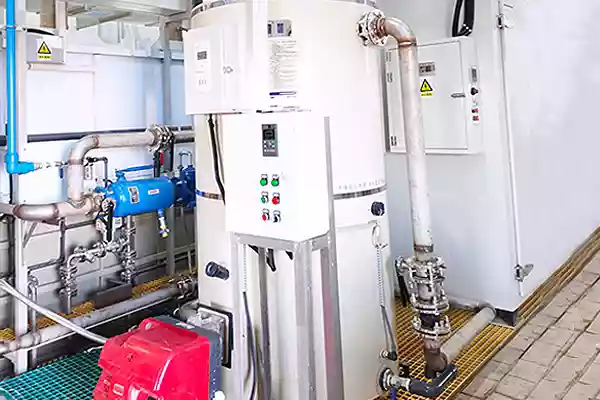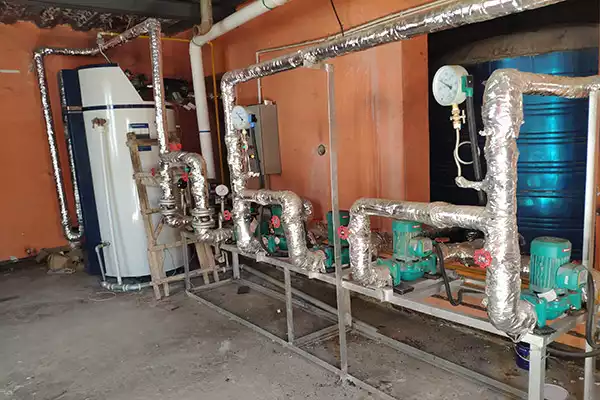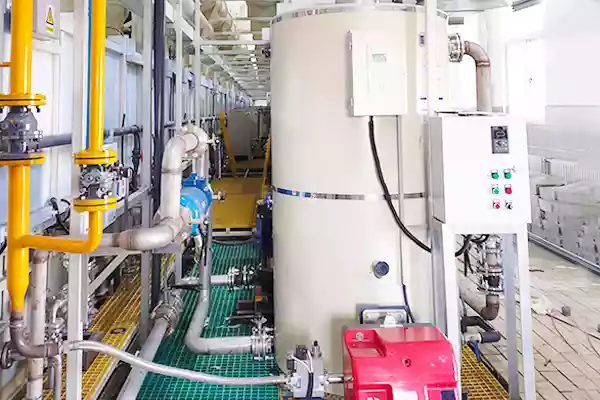
การแนะนำ
หากคุณกำลังพิจารณา ติดตั้งเครื่องทำน้ำอุ่นแบบไม่มีถัง, คุณอาจสงสัยว่ามันเหมือนกับหม้อต้มหรือไม่. Boilers and tankless water heaters do have their differences, but they can both be used for heating your home’s hot water. Here we will go over everything that you need to know about these two types of heating systems so that you can make an informed decision about which one is right for your family.
Is a tankless water heater the same as a boiler?
No. While both a tankless water heater and a boiler are hot water heaters, they are completely different devices. A tankless water heater heats water on demand, ในขณะที่หม้อต้มให้ความร้อนแก่น้ำอย่างต่อเนื่อง.
หลักการทำงาน
ที่จะรู้ว่า ความแตกต่างระหว่างเครื่องทำน้ำอุ่นแบบไม่มีถังและแบบหม้อต้ม, ก่อนอื่นคุณต้องเข้าใจวิธีการทำงาน.
เครื่องทำน้ำร้อนแบบไม่มีถังใช้เครื่องแลกเปลี่ยนความร้อนโดยให้ความร้อนแก่น้ำเย็นที่เข้ามาจนร้อนจัด. อุณหภูมิถูกควบคุมโดยเทอร์โมสตัท, ซึ่งควบคุมการเปิดและปิดเตาแก๊ส. ไม่เก็บน้ำร้อนไว้, คุณจึงใช้มากหรือน้อยได้ตามต้องการในเวลาใดก็ตาม.
The boiler system works differently. It heats up water in a large tank and distributes it through pipes throughout your home or building (instead of heating only what you need). The boiler itself heats up via combustion with natural gas or propane gas. In some cases, oil or electricity, and then pumps that hot water into radiators throughout your house for immediate use.
ประสิทธิภาพ
Tankless water heaters have higher efficiency than boilers. A tankless model may have an efficiency rating as high as 100%, while boilers typically have a rating between 80% และ 90%. This means that for every unit of energy used by the boiler, you can expect more hot water from your tankless heater.
Lifespan
Generally, the average service life of tankless water heaters is about 10-15 years, and the average service life of boilers is about 20-25 years or even longer. The reason for this difference in lifespan is that tankless models use less energy than boilers and therefore don’t need to be replaced as often. If you’re looking for longevity in your home heating system, a boiler may be a better choice than tankless technology.
Installation cost
When it comes to installation, tankless water heaters are easier to install than boilers. They’re also less expensive because they require fewer parts and less labor.
Tankless Water Heater:The average cost of installing a tankless water heater is about between $1,200 และ $2,500. This includes labor costs for installation and plumbing work as well as materials for new pipes or other tools needed during the process.
Boiler: Installing a boiler can be very expensive depending on how complicated your system needs to be. They are generally priced between $6-$10 per square foot (PSF) of space being heated by them
Required maintenance
Tankless heaters don’t require nearly as much maintenance. Because there’s no storage tank where sediment can build up over time. Therefore you only require cleanings or replacement parts like those found in traditional boilers tanks.
However, Boilers are more maintenance-intensive than tankless water heaters. Ensure they’re working efficiently and safely, with annual inspections from a professional required by law. This includes checking the pilot light and igniter, examining flue pipes for cracks or corrosion, และ Cleaning out condensate pans with soap and water. Additionally, you’ll need to replace filters on a yearly basis as well as replace any worn-out elements in order for your system to function properly.
What is the advantage of a tankless water heater?
Instant hot water: With a tankless model, you’ll never run out of hot water again! When you turn on the tap in your bathroom or kitchen sink, it instantly starts flowing at full temperature with no wait time. A big advantage over traditional storage tank systems which can take minutes or even hours to achieve optimal temperatures after being turned on.
No storage tank: Tankless models don’t store any extra water at all. Instead, they heat up only what you need right now. This means no wasted energy or space in your house!
No wasted energy: Tankless water heaters use less energy than traditional storage tank models. They don’t store hot water and only heat what you need when you need it. ดังนั้นพวกเขาจึงใช้ไฟฟ้าและก๊าซน้อยลงในการทำงาน.
ไม่มีน้ำเสีย: หลักการเดียวกันนี้ใช้กับปริมาณน้ำที่ใช้กับระบบแท้งค์มาตรฐาน. ยิ่งใครที่ใช้น้ำอุ่นหรืออาบน้ำในบ้านของคุณ, ยิ่งมีเงินและพลังงานมากเท่าไหร่ (และเป็นค่าเครื่องทำความร้อน). ด้วยระบบแท็งค์เลส, ทุกคนสามารถมีแหล่งน้ำร้อนส่วนตัวได้ตลอดเวลาโดยไม่ต้องสิ้นเปลืองทรัพยากรใด ๆ ในการทำความร้อนส่วนที่ไม่ได้ใช้ของถัง.
ไม่ต้องบำรุงรักษา: Since there aren’t any tanks involved with this type of setup. Just pipes that deliver heated fluid directly from one point to another. There aren’t any parts or filters needing regular replacement or cleaning either!
What is the disadvantage of a tankless water heater?
As with any product, there are disadvantages to using a tankless water heater. The most obvious one is that they have a smaller capacity than boilers do. ซึ่งหมายความว่าหากคุณมีครัวเรือนขนาดใหญ่หรือผู้มาเยือนที่ต้องอาบน้ำหรือล้างจานบ่อยๆ, ตัวเลือกที่ไม่มีถังน้ำมันอาจไม่เหมาะกับความต้องการของคุณ.
นอกจากจะมีความจุน้อยกว่าหม้อต้มแล้ว (ซึ่งทำให้ไม่เหมาะสำหรับครัวเรือนขนาดใหญ่). หน่วย Tankless มีแนวโน้มที่จะมีอายุการใช้งานน้อยกว่าหม้อไอน้ำ: รอบๆ 15 years โดยเฉลี่ยเมื่อเทียบกับ 25 years หรือมากกว่าสำหรับหม้อต้มบางรุ่น.
เครื่องทำน้ำอุ่นแบบไม่ใช้ถังน้ำสามารถแทนที่หม้อไอน้ำได้หรือไม่?
ในบางสถานการณ์, เครื่องทำน้ำอุ่นแบบไม่มีถังสามารถแทนที่หม้อไอน้ำได้. ตัวอย่างเช่น, หากคุณมีบ้านเก่าที่ไม่มีระบบทำความร้อนส่วนกลางและคุณต้องการติดตั้งเพื่อจุดประสงค์ด้านพลังงานอย่างมีประสิทธิภาพ, ดังนั้นการติดตั้งใหม่ของคุณจึงอาจเหมาะสมที่จะรวมทั้งน้ำร้อนและฟังก์ชันทำความร้อน.
ในกรณีนี้, การติดตั้งเครื่องทำน้ำร้อนแบบไม่ใช้ถังเป็นส่วนหนึ่งของระบบทำความร้อนส่วนกลางใหม่ของคุณจะช่วยให้ทำงานได้สองอย่าง: ให้ทั้งน้ำร้อนและความร้อนในเครื่องเดียว (ไม่มีถัง).
คุณต้องการหม้อต้มน้ำหรือเครื่องทำน้ำอุ่นแบบไม่มีถัง?
หากคุณมีครอบครัวใหญ่และบ้านของคุณไม่ใหญ่มาก, เครื่องทำน้ำอุ่นแบบไม่มีถังอาจไม่ใช่ทางเลือกที่ดีที่สุด. เหตุผลก็คือเครื่องทำความร้อนแบบไม่มีถังมีราคาแพงกว่าหม้อต้มและต้องการการบำรุงรักษามากกว่า.
หากคุณมีครอบครัวขนาดเล็กและบ้านของคุณไม่ใหญ่มาก, ดังนั้นการติดตั้งระบบน้ำร้อนตามสั่งจึงอาจเหมาะสม. บนระบบเหล่านี้, ไม่มีถังเก็บจึงสามารถจ่ายน้ำร้อนได้ทันทีโดยไม่ต้องรอระหว่างการใช้งาน (เช่น., ไม่ต้องรออีกต่อไปในขณะที่มีคนอาบน้ำ). These systems also don’t require any extra space in your basement because they are installed above ground level where there’s plenty of room for them!
How much do tankless water heaters cost?
If you’re looking to install a tankless water heater in your home, you should know that these units are often more expensive than traditional ones. The upfront cost of a tankless heater can range from $5,000 ถึง $12,000. However, this will depend on how much work needs to size, brand, and other factors.
The annual operating costs vary depending on whether you choose electric หรือ natural gas as your fuel source. The electricity is cheaper but requires an electrical outlet nearby. Although natural gas has higher initial costs. But lower operating expenses over time because of its lower price per BTU.
Let’s say that your current electric water heater costs $10 per month in electricity bills and lasts 10 years before breaking down (that’s about $1,200). If this is the case for your household, then installing an electric tankless unit could pot Essentially save around $1,000 over those 10 years and even more.
บทสรุป
When it comes to choosing between a tankless water heater and a boiler, there are many factors that you can consider. You should take into account the working principles of both systems, their efficiency, and their lifespan. In addition, ค่าใช้จ่ายในการติดตั้งและการบำรุงรักษาที่จำเป็นจะส่งผลต่อกระบวนการตัดสินใจของคุณด้วย. หากคุณต้องการทราบข้อมูลเพิ่มเติมเกี่ยวกับรายละเอียดของเครื่องทำน้ำร้อนและหม้อต้มแบบไม่ใช้ถัง, กรุณาติดต่อเราได้ที่ +0086 186-2391-5479.
Get your best price
Quickly compare 3 FREE quotes
- Engineer quick quote
- The overall delivery speed is fast
- Financial choice
- Low installation costs and cost savings
25 years+ of boiler R&D
More than 20 innovative technologies



